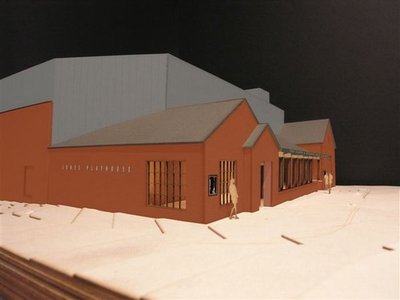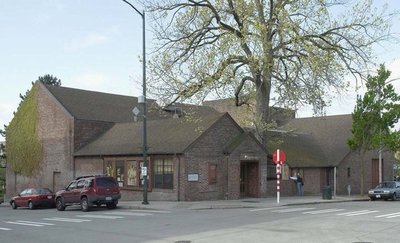May 24, 2007
Raising the roof to give the Playhouse Theater a new life
When the Undergraduate Theatre Society’s production of Into the Woods closes on June 3, the theater in which it’s being performed will close too — for nearly two years. The Playhouse Theater on University Way is going to get a facelift — and it will be more than superficial.
The playhouse has been a “distressed building” for a long time, said Sarah Nash Gates, director of the School of Drama. “It’s an unreinforced brick building, so safety is a huge problem,” she said. “It doesn’t meet any kind of current code. The heat and water systems are failing, or have failed regularly.”
But the building is also a historic one. Originally a tile warehouse, it was converted to a theater in 1930 and became the home of the Seattle Repertory Playhouse, a private theater operated by Florence and Burton James. Then, when the Federal Theatre Project was created as a way to employ out-of-work theater artists during the Depression, the Jameses also directed a “Negro Theatre Unit” of the Federal Theatre Project, some of whose plays were performed in the playhouse.
“It was one of the first places where black and white actors were on the same stage in the same play — and that was absolutely revolutionary at the time,” Gates said.
Given its history, it isn’t surprising that despite its small size and lack of classrooms, the playhouse wound up on the University’s list of the 15 buildings in most critical need for total renovation several years ago. And given its connection to what Gates calls “liberal social causes and issues,” the school was able to find a donor willing to augment what the state allocated for work on the building. Floyd Jones, a UW alum who holds such causes dear, gave $2 million, which together with the state’s $7.5 million, will allow the School of Drama to create a far superior theater to the one they have now. The renovated building will be called the Floyd and Delores Jones Playhouse.
The major change will be achieved by literally raising the building’s roof. “In the process of the early design/development stage with LMN Architects, it became very clear that if we could just move this one beam — a major structural beam that ran across the seating bowl, if that could get raised, all kinds of wonderful things could happen that would allow the theater to be a better theater,” Gates said.
The beam will indeed be moved, and the higher roof will allow for better lighting angles and also access to lighting positions via a catwalk. Since under the current setup, lighting technicians have sometimes had to reach the lights by balancing a ladder on the seats, the move will not only improve the artistic situation but also the safety situation.
Raising the roof also allows for more steeply raked seating. This will bring rows a little closer together, Gates said, which will allow the audience to “feel more intimate and connected with the stage.” The steeper seating in turn means that the theater will have “vomitory” entrances — routes to the stage through which actors can pass under the seats and therefore out of view of the audience.
The audience will reach their seats via a stairway from the lobby, but there will also be an elevator to allow access for the disabled. Dressing rooms will be moved to the second level, allowing restrooms to be moved from their current position off the west side of the lobby, and the lobby will be extended in that direction.
The lobby will also be extended north with the removal of an elm tree that currently takes a “bite” out of that side of the building. “The tree was there back when the building was a tile warehouse,” Gates said. “We had it examined by an arborist and it was determined that it probably has a limited life expectancy and its roots are damaging the building.”
New trees will be planted on both the University Way and 41st Street sides of the building. And wood from the elm will be used to build benches for the theater lobby.
The main entrance is being moved to the west end of the lobby; the current entrance will serve as an emergency and after-the-show exit.
Gates said she and a committee from the School of Drama had been working with the architects for two years as plans for the building took shape. The committee included General Manager for Production Anne Stewart, Assistant Professor and Lighting Designer Geoff Korf, Professor and Scenic Designer Thomas Lynch, Technical Director Bob Boehler, and Scene Shop Manager Alex Danilchik. They’ll continue to oversee the process as work begins, she said.
Bids are due to be opened June 27, and construction may start as early as Aug. 1. It is scheduled to be finished by September of 2008, with occupation by December of that year. Gates said a gala reopening is tentatively planned for April of 2008.
With the Playhouse unavailable in the meantime, the School of Drama will do more shows than usual in the Meany Studio Theatre and especially in the Penthouse Theatre. Because of the short turnaround time that will mean for each show, they’ll be building less scenery. But there’s no doubt in anyone’s mind that it’s worth it.
“We are really excited,” Gates said. “This will feel in every way like a brand new theater.”
‘Into the Woods’ is Playhouse finale
The final show at the Playhouse Theater before its renovation is Into the Woods, an award-winning musical by Stephen Sondheim. It’s a story of family, love and hope that blends familiar fairy tales with the darkly comic story of a childless baker and his wife, who catalyze the action of the play by attempting to reverse a curse in order to have a child. Through the interwoven characters of children’s tales, this performance will delve into the meaning of loss and the search for fulfillment while bringing to life Sondheim’s intricate songs.
Performances run from May 24 through June 3, with tickets available at www.brownpapertickets.com. Shows are at 8 p.m. Wednesday through Saturday with performances at 2 p.m. on Sundays.


